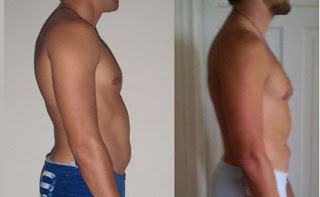Summer is my favorite time of year. I love nothing better than a summer day at the pool–swimming, sunning, staring. Staring? Yes staring. As somebody who spends most of his time looking at bodies, I simply can’t help but notice–and be intrigued by–the variety of differences and similarities among people when it comes to physical structure. No better place than the pool for a little weekend science.
One thing I’ve noticed is that, as people age, the gravity-induced musculoskeletal stresses that shape their bodies do so in predictable ways. For instance, I notice that both men and women are prone to developing excessive low back arch, which could easily be mistaken (by them) for a belly (beer belly, immaculate conception, etc).
During my career as a sports chiropractor, and probably no less a result of the city in which I’ve chosen to practice, I have met numerous people that look into, and undergo, tummy tuck procedures, usually done in an attempt to free themselves of this suspected baggage. On more than one occasion, I’ve actually gotten to observe post-vacuumed mid-sections, and I must say…I haven’t always seen much of a difference.
 |
| Excessive arch (hyperlordosis) Normal Arch |
So being naturally curious, I always feel compelled to ask why. As I mentally compare these bodies–of both the liposuctioned, yet belly-retained, and of the people that I observe poolside–I notice the downward projection of the belly button, which is more a consequence of hyperlordosis–or excessive arch–than it is of belliness (see photo to right to get better picture of what I’m talking about).
Having a reference point is a must, because I have to be sure that it’s simply not normal posture (which would then, in fact, implicate the bulge as being a belly, after all–still following me?). Fortunately, the pool where I live has a wide variety of people of every race, creed, color, size, ethnicity, sex and age. A researchers dream!
Compared to younger people (yes, a purely subjective categorization…but I’m calling this observation, not fact), I find that older people tend to have more arch, which I ascribe to tight hip flexors. Listen, I evaluate enough people to know that many of us, especially those with low back pain, have tight hip flexors. I also know that a hyper-arched low back is the postural consequence of tight psoas muscles (part of the hip flexor complex)…so it’s not rocket science.
Here’s the point: If you find that the ‘belly’ you see when looking in the mirror doesn’t go away no matter how many sit-ups you do, or how little you eat, and you’ve even been contemplating surgical enhancement, why not start by stretching? Regular flexibility work, particularly focused on the hip flexors–psoas major, iliacus, quadriceps femoris (quads)–might just be the answer.
Gravity affects us all. We can let it do it’s thing over time (and try to counter with a tummy tuck, which is often only negligibly successful) or we can invest the energy NOW (it’s never too late) to stretch the tight, short muscles that have been deformed by gravity, and return to the youthful posture we’ve all once had (and some still have). It’s your choice, but I think if you try the latter you’ll be pleasantly surprised.














